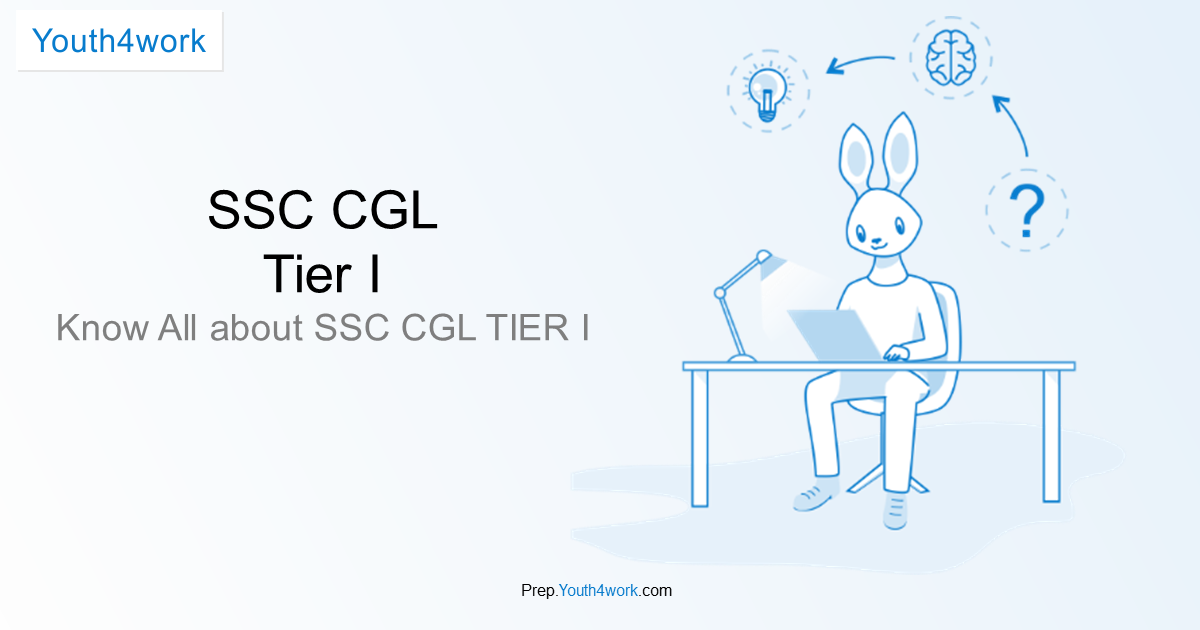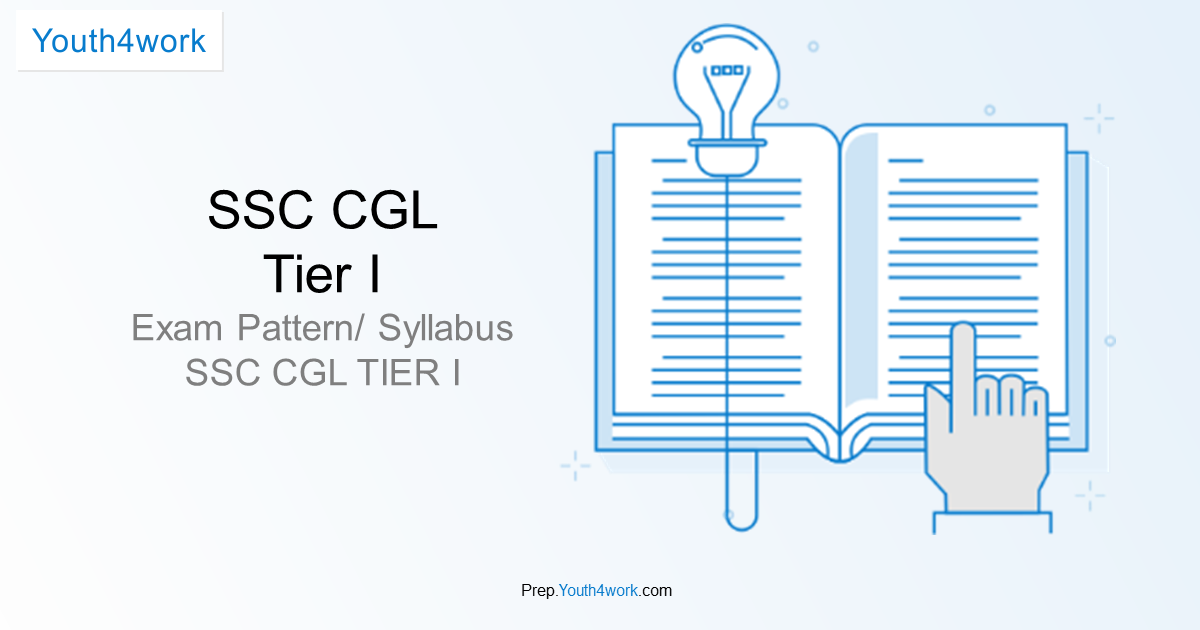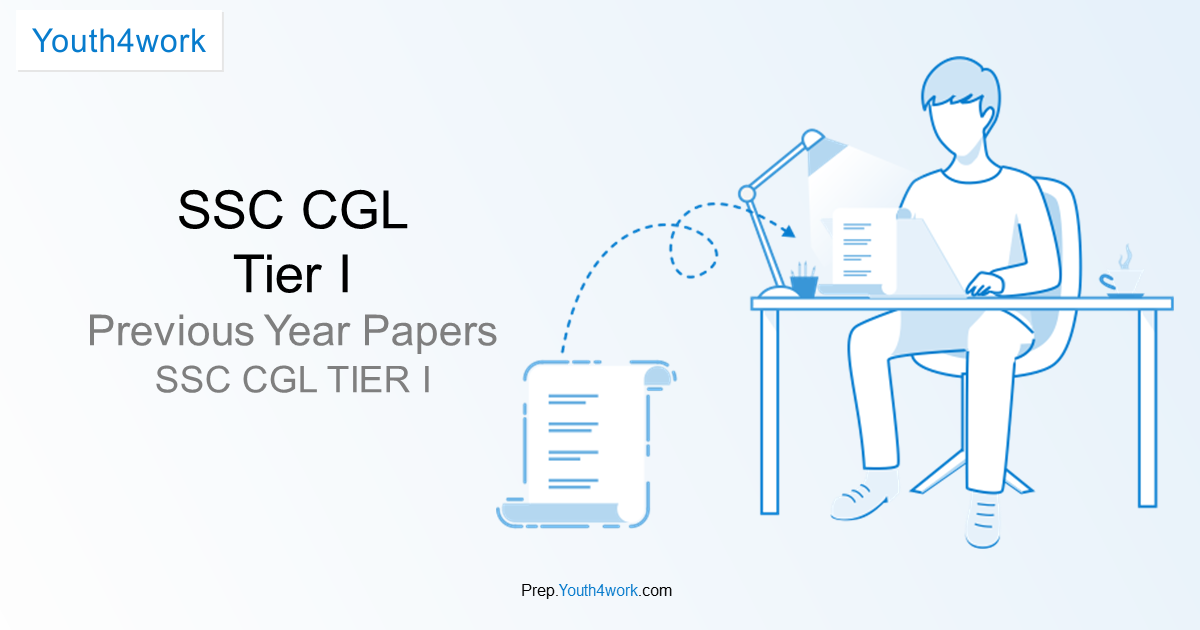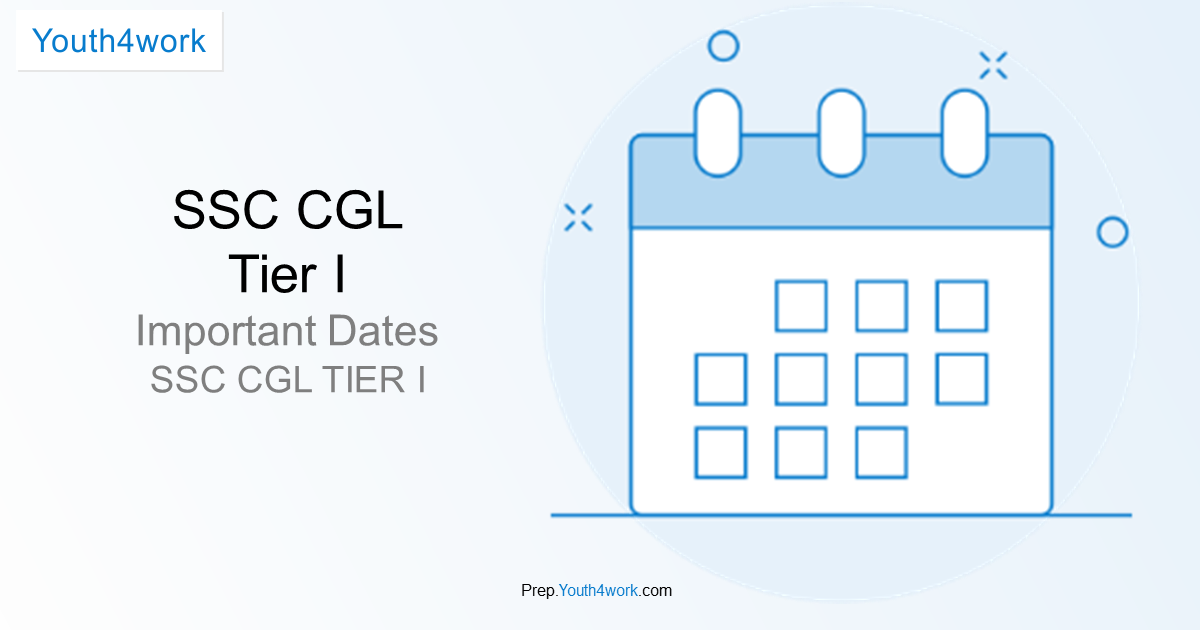SSC CGL Important Dates, Selection Process, Eligibility, Application Form, Admit Card, Exam Pattern, Marking Scheme, Syllabus, Tips and Tricks, Previous Year Papers
Staff Selection Commission (SSC) is an organization under the Government of India responsible for recruiting candidates for different posts in various Ministries and Departments of Government of India and in Subordinate Offices. SSC conducts a Combined Graduate Level (CGL) exam every year for recruitment in Group ‘B’ (non-technical) and Group ‘C’ (non gazetted) posts. The selection process of SSC is by conducting exam in four levels, namely, Tier-I, Tier-II, Tier-III and Tier-IV. The CGL Tier-I exam is an online computer based objective type exam consisting of 100 questions to be answered in 60 minutes, time extended up to 20 minutes more for physically challenged candidates. The number of posts offered is different every year depending on the number of vacancies generated. The age limit for the various posts varies between 18 years to 32 years.
Eligibility | Exam Pattern | Syllabus | Tips & Tricks | Take Free Mock Test
मुख्य हाइलाइट
SSC CGL TIER 1 का

Application Fees
Rs.100 (General & OBC)
No Fees (SC/ST/Pwd/Females)

Exam level
National

Eligibility
Bachelor's Degree from a recognized University

Age Limit
18 To 27 Years (For Group B and C)

gender
Males & Females

Selection Process
SSC CGL Tier 1, SSC CGL Tier 2, SSC CGL Tier 3, SSC CGL Tier 4
Table of Contents
-
SSC CGL Important Dates
-
SSC CGL Selection Process
-
SSC CGL Eligibility
-
SSC CGL Application Form
-
SSC CGL Admit Card
-
SSC CGL Exam Pattern
-
SSC CGL Marking Scheme
-
SSC CGL Syllabus
-
SSC CGL Tips and Tricks
1. SSC CGL Important Dates
-
The notification for the SSC CGL will be published before the application starts
-
The exam is held every year to recruit Inspectors
SSC CGL Registration Period
-
The online registration (Application form submission) will be begun on 21 December 2020
-
Application form (Registration) will be closed on January 2021
-
SSC CGL prelims admit card will be released before 10 days of the exam
-
Prelims exam will be conducted from 29 May to 07 June 2021
-
Prelims result date is to be announced
-
Admit card for mains will be released before 10 days of the mains exam
-
The mains exam will be conducted after the prelims exam
-
Result declaration date of mains exam is not announced yet
2. SSC CGL Selection Process
- Tier-1: Preliminary Exam
- Tier-2: Mains Exam
- Tier-3: Writing Skills (Offline Descriptive Exam)
- Tier-4: Computer Proficiency Test CPT/ DEST
3. SSC CGL Eligibility
Nationality
-
The applicant must be a citizen of India OR
-
A subject of Nepal/ Bhutan/ Tibetan Refugee settled in India before 1962 OR
-
The persons migrated from Pakistan, Burma, Sri Lanka, East African Countries, Zaire, Vietnam
-
The NRI candidates are not eligible
SSC CGL Age Limit
-
The minimum age limit is 18 years as on 01 January 2020
-
The maximum age limit is 30 years as on 01 January 2020
-
The maximum age varies according to the post
-
The candidate should be born before 01 January 2002 and after 02 January 1990
-
Age Relaxation
-
General: No age relaxation
-
OBC (Non-Creamy Layer): 03 Years
-
SC/ST: 05 Years
-
Widows, Divorced Women, Women legally separated from their husband and not remarried: Eligible up to 35 years
-
Widows, Divorced Women, Women legally separated from their husband and not remarried (SC/ST): Eligible up to 40 years
-
Persons with disabilities (GEN): 10 Years
-
Persons with disabilities (OBC): 13 Years
-
Persons with disabilities (SC/ST): 15 Years
-
SSC CGL Educational Qualification
-
Minimum graduation degree from a recognized university to be eligible
-
SSC does not require any minimum percentage in graduation
-
The SSC releases the information of the mandatory eligibility criteria on the official site in the notification
-
The aspirants should read the eligibility criteria carefully before applying for the exam to avoid circumstances
-
The main factor of change in eligibility is the age limit because the period in which DOB should lie changes with time
-
Operating and working knowledge of computer to take prelims and mains exam
4. SSC CGL Application Form
-
The candidates will apply on the official site of the SSC
-
The SSC invites application form to the candidates for filling the vacancies of Inspectors
-
The SSC publishes a calendar every year containing information of the exam incidents
-
The SSC releases notification on the official site to fill the application form
-
This notification contains the information of registration period, required documents, vacancies, exam date, relevant eligibility conditions, etc
-
The application form filling will be started once the application form filling notification releases
-
The candidates are advised to read the eligibility criteria carefully before applying for the exam because the candidature of ineligible candidates will not be acknowledged
SSC CGL Application Fee
-
Gen/OBC: INR 100/-
-
SC/ST/Other: Nil
-
The application fee (exam fee or registration fee) can be paid via net banking, mobile wallets, IMPS, Cash card, debit card, credit card, etc
SSC CGL Application Form Filling Process (Registration Process)
-
The candidates are advised to fill the application form carefully and they should recheck the details filled by them before final submission
-
There is no provision of the correction window
-
If the candidate has made mistake in application form filling, he can apply again by filing a new application form
-
The application fee once submitted will not be refunded under any circumstances, so the candidates will have to make a fresh payment to pay the application fee
-
The application form will be filled in the below simple steps
-
(a). Complete Registration
-
(b). Upload Photo and Signature
-
(c). Fill Application Form
-
(d). Pay Application Fee
-
-
The personal information of the candidates is required like class 10/12/graduation certificate, category certificate (if applicable), etc during the form filling
-
The post, exam center preference, etc also asked on filling the application form
-
The candidate's photo and a signature will be required during the application form filling
-
Photo Size: 20-50 kb
-
Signature: 10-20 kb (Scan Copy)
-
-
The face and eyes should be visible on the photograph
-
The signature should be also clear. It will be matched in the future use
-
The signature should not be in capital letters
-
The candidates should read instructions carefully before application form filling
-
The candidates should note down the registration number and password for further use
-
They should print out the application form copy in a white blank paper to keep all the information with them for further use
5. SSC CGL Prelims Admit Card
-
Candidates can download the admit card from the official site of SSC
-
SSC releases the admit cards on its 9 regional sites
-
Admit card will be available to download before minimum 7-10 days of the exam
-
The candidates should print the admit card on a white blank paper
-
The text and information printed on the admit card should be visible and readable
-
The candidates are advised to save a copy of the admit card for future use
-
The candidates should have clear information about the exam pattern and marking process before attempting the real exam. They are advised to make a wise strategy to acquire more marks than the cutoff
-
The admit card will be available to download till the exam
-
Adress and photograph of identity proof should be matched to the uploaded records
-
They should also carry two passport size photograph matches to the uploaded one
Steps to download SSC CGL Prelims Admit card
-
The SSC provides a link on its official site to download the admit cards
-
Fill the credentials like registration number, roll number, password, date of birth, etc
-
Mostly these credentials are available on the printed copy of the application form
-
After filling the credentials, they will reach on the admit card
-
Now they can print or download the admit card
-
In case of forgetting the password, they can use the forget password option. The login information will be sent on the registered mobile number or mail
Information in the SSC CGL Prelims Admit card
-
Roll Number/ User id and password
-
Name and address of the candidate
-
Registration number of the candidate
-
The venue of the examination center
-
Date and time of the examination
-
Date of Birth
-
Candidate's photograph and a blank space to affix the candidate's photograph matching to the uploaded one
-
Boxes containing space for signature and thumb impression of the candidate
-
A box for the signature of the invigilator
SSC CGL Exam Day Instructions
-
The candidates are advised to follow all the instructions printed on the admit card
-
The instructions printed on the admit card should be clearly readable. Instructions make the candidate aware of attending the exam
-
Original copy and photocopy of a valid identity proof containing photograph and address is required in the examination hall
-
The candidates will be disqualified for misconduct in the examination
-
The candidate must have the same information and signature in each document
-
The SSC will not acknowledge any change in time, date, center of the examination, etc
-
digital devices, earphones, unnecessary objects are not permitted to bring into the exam hall
-
The SSC will handle the situation and co-operate with the candidates in case of administrative or technical issue
-
The candidates have to Wear mask and gloves during the exam
-
The candidates should carry minimum 50 ml sanitizer in a transparent bottle
-
The candidate should install Arogya Setu App
The discrepancy in SSC CGL Admit card
-
The candidates should cross-check the information in the admit card
-
They should make sure that there is no mismatch in the details of the admit card and identity proof
-
If there is any discrepancy, they should bring it in front of the SSC
6. SSC CGL Exam Pattern
-
The correct understanding of exam pattern and marking process to answer the questions with a planned strategy directs towards the bright score
-
The SSC is responsible to set up exam pattern and the marking process
-
The exam conducting body mention exam pattern and marking scheme on the notification of application form filling
-
The written exam is conducted in 3 stages
-
Preliminary Exam
-
Mains Exam
-
Writing Skills
-
-
The prelim and mains exam will be conducted in online mode and questions will be objective
-
The writing skill test will be in descriptive mode (offline)
-
Each MCQ contains 4 options to opt right answer amongst them
-
Exam level will be national-level
-
It is a computer-based exam
-
Exam duration will be:
-
60 minutes for prelims
-
120 minutes for each paper of mains
-
60 minutes for Tier-3
-
-
Paper will be available in both Hindi and English Language
-
Total questions will be:
-
100 in prelims
-
500 in mains
-
01 in Tier-3
-
-
Number of sections (Prelims)
-
1. English Language: 25 MCQs (2 Mark for each)
-
2. Quantitative Aptitude: 25 MCQs (2 Mark for each)
-
3. General Intelligence and Reasoning: 25 MCQs (2 Mark for each)
-
4. General Awareness: 25 MCQs (2 Mark for each)
-
-
Number of Papers (Mains)
-
1. Quantitative Abilities: 100 MCQs (200 Marks)
-
2. English Language and Comprehension: 200 MCQs (200 Marks)
-
3. Statistics: 100 MCQs (200 Marks)
-
4. General Studies (Finance and Economics): 100 MCQs (200 Marks)
-
-
The candidates will write essay/ precis/ letter/ application in Tier-3
7. SSC CGL Marking Scheme
-
The marking process is similar in both exams except English Language and Comprehension Paper of the mains exam
-
2 mark will be awarded for each correct answer, 1 mark will be awarded in English Language and Comprehension Paper of the mains exam
-
1/4 of the allotted mark of a question will be deducted for each wrong answer
-
0.50 mark will be deducted for each wrong answer, 0.25 mark will be deducted for English Language and Comprehension Paper of the mains exam
-
There is no negative mark or inclusive mark for unattempted questions
-
The exam will be conducted online, so marking two answers of a question is not possible in CBT
-
Negative marking not only prevents to gain mark but also shorten score by penalty
-
The candidates are suggested to mark the answers with accuracy to lessen the impact of negative marking
-
The four wrong answers mark deduction value is equal to the one right answer mark gaining value
-
To excel in the exam, candidates should focus on accuracy in solving the questions
-
The marking process is the same within each section and paper except English paper of the mains
-
The implementation of knowledge works more than the only having information that answers the query "How negative marking affect the score that drives the candidates score below the cutoff?"
-
The SSC implements the marking scheme in the exam
-
The candidates have to clear the cutoff to be eligible for the next tier. They have to clear the overall cutoff to come on the merit list
-
We should never mark guess based answer
-
Reduce time consumption to answer the questions during the exam
8. SSC CGL Syllabus
It is divided into 4 sections:
Reasoning: covers topics like Bar Graph, Line Graph, Pie Chart, Tables, and Caselets.
Quantitative Aptitude: covers topics like number system, HCF, LCM, Simplification, Decimals & fractions, ratio & proportion, unitary method, percentage, time & distance, time & work, profit & loss, simple & compound interest, and Algebra.
English Language: covers topics like grammar, vocabulary, sentence structure, Synonyms-Antonyms, reading comprehension and para jumbles.
General Awareness: covers topics like what’s happening in the country as well the world with the knowledge of sports, economy, current affairs, awards &honours’, scientific research, history along with important dates
9. SSC CGL Tips and Tricks:
-
Take Mock tests online to know your Strengths and Weakness.
-
You must also have the full knowledge of English like Sentence Structuring, Grammar, conjunctions and so on for that learn and practice along with it take Mock Tests every now and then.
-
Have full knowledge of Verbal as well the Non-Verbal type of exams.
-
Must have the full knowledge of Reasoning and Quantitative Aptitude.
-
Should know about Reading Comprehensions well.
-
Solve last years’ question papers in order to know what to expect and it will test your speed as well as accuracy.
-
Wrong answers will fetch you the 0.25 marks of the right answers obtained.
-
Prepare yourself for the timing of the exam so that you will able to finish well in time.
-
Don’t be anxious and before going to examination hall eat properly, have proper sleep and just relax.
Youth4work Prep Tests
Online practice tests for competitive exams – are very unique and popular among aspirants. Aspirants can take self-designed mock-tests as well as practice for sections and topics separately. Youth4work’s unique and proprietary technology is helping lakhs of aspirants to reveal personal details on what are the strength areas of aspirants for any exam and also suggest how they can improve the performance.
Following are interesting insights from nearly lakhs of question attempts on SSC CGL Tier-1 exam practice tests on Youth4work. Every aspirant is rated on a Rating Scale. The ratings of the aspirants change with every question attempt.
डाउनलोड
केस स्टडी, नोट्स, पिछले साल पेपर
चर्चा मंच
समान प्रतिभा वाले युवक/युवती इस प्रश्न का शीघ्र उत्तर देंगे।











